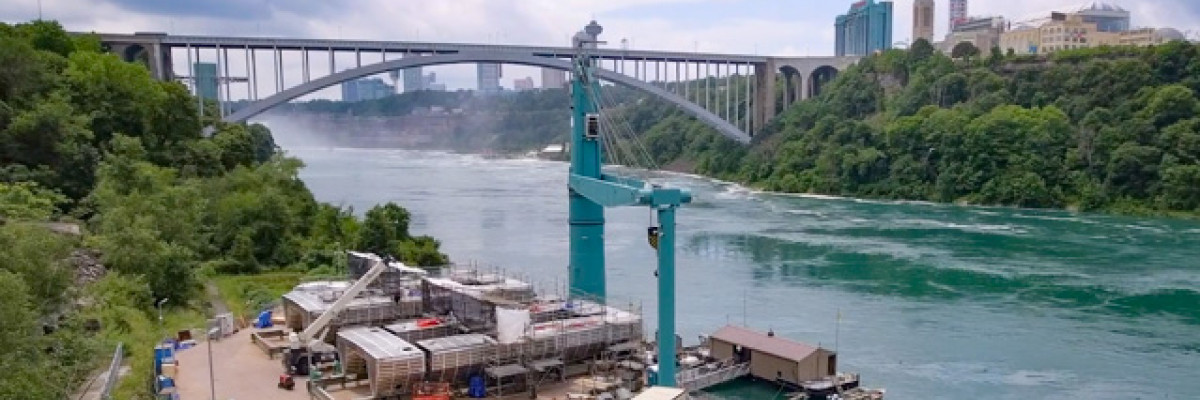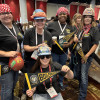When it comes to welding these boats, they’re not taking any chances. They want it perfect, and that’s what we’re gonna give them.
Marshall Morrisey, Local 5, Zone 7, sands the bulwarks in preparation for painting.
View Photo Gallery (5 photos)
MORE THAN 20 MILLION tourists from around the world visit Niagara Falls each year to marvel at the massive power of 600,000 gallons-per-second of water rushing down the Niagara River, roaring over the trio of falls and crashing like liquid curtains over the rocky riverbeds 160-some feet below. Of those 20-plus million annual visitors, more than 1 million will take a ride against the river current on the famed Maid of the Mist boat tour to experience the mighty falls from a unique—and wet—on-the-water vantage point.
“It’s awe inspiring when you’re up in the Horseshoe on the bow of the boat looking up at the falls. It’s really something you can’t find anywhere else,” says Christopher Glynn, president of the Maid of the Mist Corporation. “The volume of water is impressive; it’s the sheer volume of it.”
And getting the passengers up river and up close to the falls is impressive in its own right, requiring vessels powerful enough to cut against the current—and sturdy enough to do it safely with hundreds at a time on board. To do so, Maid of the Mist, which is one of the oldest Niagara Falls tourist attractions, has innovated far from its beginnings as an 1846 ferry boat—a 72-foot side wheeler with an 18-foot beam, powered by steam generated from a wood- and coal-fired boiler. The current fleet is two trusty steel diesel-powered, two-deck tour vessels built in 1990 and named Maid of the Mist VI and VII.
The latest Maid of the Mist iterations might, however, be the company’s most remarkable advancement. And Boilermakers from Local 5, Zone 7; Local 744; Local 5, Zone 175; and Local 5, Zone 197 are in on it: Two all-electric, emission-free, vessels with aluminum catamaran hulls—the first of their kind, and perhaps the first anywhere in the world. The new fleet will run on 400 kW motors powered by 316 kWh batteries which, after the 20-minute ride to the falls, charge to 80% in just seven minutes.
“Niagara Falls is one of the largest producers of hydro-electric power in the world,” says Glynn. “And so we want to harness that energy for our own purposes and be carbon neutral and environmentally friendly.” Plus, he adds, the new boats will have far superior maneuverability.
No surprise, this was no ordinary project. Building the boats had two prime challenges: The location and the material. Before work could begin in May 2019, Boilermakers were tasked with figuring out how to rig and fly the equipment and materials needed down a couple hundred feet from the top of the river gorge to a dry dock on the banks below.
“When I first came out to the job site and met with contractor Hohl Industrial, we took a look at the challenges ahead. We have to fly the pieces down 200 feet,” says Michael Bogue, assistant business manager for Local 5, Zone 7. “That means you have to have a crane big enough to fly the pieces out. I believe the crane’s putting them out 140 feet, flying the pieces down 200 feet.
“And it’s not just the pieces of the boat: You’ve got a crane you’ve got to get down here, you’ve got semi’s you’ve got to drop down, you’ve got walls, all the equipment that goes with it. When you’re lowering pieces that far, you’ve got all kinds of challenges. I think Boilermakers, they put their heads together and they came up with a plan; and I think the guys are doing a fantastic job.”
Adds Local 5 BM-ST Steve Ludwigson, “We were fortunate the Boilermakers in Zone 7 are very familiar with what they have to do rigging wise.”
Then there’s the matter of the boats themselves. According to a Maid of the Mist press release, the vessels were designed by Propulsion Data Services and built as modules by Burger Boat Company in Wisconsin before being transported to Niagara Falls and lowered down to the dry dock by Boilermakers to be put together by Boilermakers. The modules are made of aluminum, which is subject to swelling in the northern New York sun.
“When you’re welding aluminum, there’s a few factors,” Bogue explains. “Aluminum has to be clean. Aluminum sitting out here in the sun, it actually grows. So when you’re laying something out or you’re going to weld something up, you know it can change from morning to afternoon. Our guys, they took a lot of effort to come into the hall practicing daily, getting ready for the weld test to go ahead and put these together. There were different welding procedures the guys came in and practiced to make sure when we got down here we had it right.
“Our guys are constantly trying to better themselves, so the hall is always open. They can come in, they can practice.”
There’s certainly a lot at stake to ensure the safety of the millions who will ride the boats into the falls’ spray.
“There’s no room for error,” Bogue continues. “You’ve got the Coast Guard that comes and does the inspections. You’ve got the X-rays they come in and inspect the welds with. When it comes to welding these boats, they’re not taking any chances. They want it perfect, and that’s what we’re gonna give them.”
The inspections have gone excellent…We have one hell of a crew here, and they’ve been doing a hell of a job.
Boilermakers have proved to be problem-solvers throughout the unique project.
“Every day it seems like there’s something new that comes up, with a different weld procedure we need to follow or a module is not fitting the way it should. There’s just everybody putting their heads together and actually getting it done,” says Brian McGuinness, project manager with Hohl Industrial. “The inspections have gone excellent…We have one hell of a crew here, and they’ve been doing a hell of a job.”
Bogue concurs: “The crew we have out here working on these boats, it’s fantastic. They’ve all come through the apprenticeship with the Boilermakers. They take a lot of pride in what they do, and they’re very good at what they do. And I think it shows with the craftsmanship they’re doing down below.”
In late October, the Maid of the Mist Corp. floated one of its new vessels, and as of November, work was continuing on the vessels in anticipation of a possible sea trial by the end of 2019. The new yet-to-be-named Maid of the Mist vessels are planned to launch in Spring of 2020. When they do, general foreman and Local 5, Zone 7 Boilermaker Jim Motak is ready to take the passenger-ready maiden voyage.
“I want to take the last ride on the old boat, and I want to be on the first ride on the new boat,” Motak says. “Some people are like ‘Oh, it’s like the Titanic;’ but I know the quality that’s going in the thing, so I want to be on that first ride.”











